4.6: Presidential Election Procedures
- Page ID
- 2033
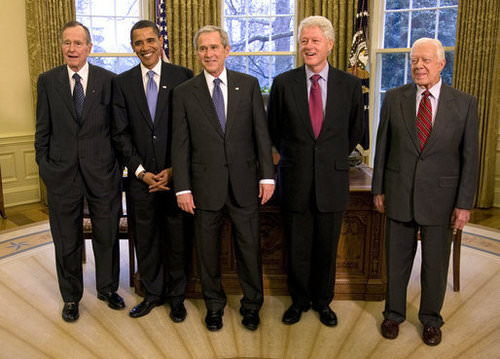
The current century sees a different presidency than the one created at the end of the 1700s. Constitutional provisions limited the early presidency, although the personalities of the first three--George Washington, John Adams, and Thomas Jefferson--shaped the office into a more influential position by the early 1800s. However, throughout the 1800s until the 1930s, Congress was the main branch of the national government. Then the balance of power shifted dramatically so that the executive branch currently as at least equal power to the legislative branch.
Qualifications, Selection, and Succession
Video: Qualities and Characteristics of Presidents
No Person except a natural born Citizen, or a Citizen of the United States, at the time of the Adoption of this Constitution, shall be eligible to the Office of President; neither shall any Person be eligible to that Office who shall not have attained to the Age of thirty five Years, and been fourteen Years a Resident within the United States.
ARTICLE II, SECTION 1, CLAUSE 5
According to the Constitution, the president must:
- be a natural-born citizen of the United States
- be at least thirty-five years old;
- have been a permanent resident in the United States for at least fourteen years.
A person who meets the above qualifications is still disqualified from holding the office of president under any of the following conditions:
Under the 22nd Amendment, no person can be elected president more than twice. The amendment also specifies that if any eligible person who serves as president or acting president for more than two years of a term for which some other eligible person was elected president, the former can only be elected president once. Scholars disagree whether anyone no longer eligible to be elected president could be elected vice president, pursuant to the qualifications set out under the Twelfth Amendment. [69]
Under Article I, Section 3, Clause 7, upon conviction in impeachment cases, the Senate has the option of disqualifying convicted individuals from holding other federal offices, including the presidency. [70]
Under Section 3 of the 14th Amendment, no person who swore an oath to support the Constitution, and later rebelled against the United States, can become president. However, this disqualification can be lifted by a two-thirds vote of each house of Congress.
The founders feared the masses. Cautious about granting powers to the general voting public, they created a safety valve against popular will. The American people do not technically elect their president. Electors do.
Controversy: "The Natural-Born Citizen" Clause
Status as a natural-born citizen of the United States is one of the eligibility requirements established in the United States Constitution for election to the office of president or vice president. This requirement was intended to protect the nation from foreign influence.
The Constitution does not define the phrase natural-born citizen, and various opinions have been offered over time regarding its precise meaning. A 2011 Congressional Research Service report stated that
The weight of legal and historical authority indicates that the term "natural born" citizen would mean a person who is entitled to U.S. citizenship "by birth" or "at birth," either by being born "in" the United States and under its jurisdiction, even those born to alien parents; by being born abroad to U.S. citizen-parents; or by being born in other situations meeting legal requirements for U.S. citizenship "at birth." Such term, however, would not include a person who was not a U.S. citizen by birth or at birth, and who was thus born an "alien" required to go through the legal process of "naturalization" to become a U.S. citizen.
The natural-born-citizen clause has been mentioned in passing in several decisions of the United States Supreme Court and lower courts dealing with the question of eligibility for citizenship by birth, but the Supreme Court has never directly addressed the question of a specific presidential or vice-presidential candidate's eligibility as a natural-born citizen.
A great deal of debate has been raised over the eligibility of President Barrack Obama to serve as president, much of which has been addressed in the argument that regardless of his African father, his mother was a natural born American citizen and thus he automatically became a natural born citizen regardless of his place of birth (by way of his mother’s citizenship status). This same criticism may be made of Ted Cruz who was born in Canada to a Cuban father and an American mother. The present interpretation is that as long as one parent is a natural born citizen of the United States, a child is automatically considered a natural born citizen regardless of the place of birth. But this still becomes a hotly debated topic as the true definition of “natural born” has never been determined.
Presidential Selection and Succession

Selection
According to the Constitution, the president serves a four-year term in office. The 22nd Amendment further requires that a President may not be elected more than twice, nor serve more than a total of ten years. The Constitution also created an electoral college to select the president.
Some of the founders wanted to select a president by popular vote, but others did not want to put that much power into the hands of the voters. Others believed that Congress should select the president, but then, what would happen to the separation of powers and checks and balances? So they compromised and created a special body of electors to be selected by the states. The number of electors would be equal to the sum of a state’s Senators and Representatives, so that large states would have more electors than the small ones.
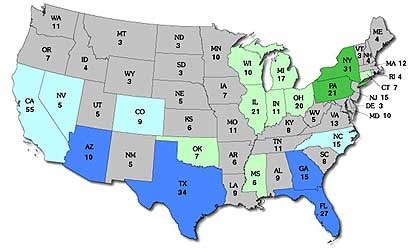
Today many people believe that the Electoral College is out of date and that presidents should be chosen by direct election, just as members of Congress are selected. By convention, state electors vote for the candidate that the people select in the general election, but they are not necessarily bound to do so.
The Electoral College also adds one wrinkle — it is possible for a president to win the popular vote and still lose the election. For example, if the Republican candidate gets even one more vote than the Democrat, all the states’ electoral votes go to the Republican. Therefore, if a candidate wins small states by large pluralities and loses large states by narrow margins, it is possible to gain more votes than an opponent and win fewer electoral votes. Four presidents — John Quincy Adams, Rutherford B. Hayes, Benjamin Harrison, and George W. Bush — have been elected in this fashion.
Succession
The Constitution originally said little about presidential succession. It only specified that powers and duties should "devolve on the vice president." Numerous succession situations over the years have shaped the current policy, defined in the 25th Amendment, adopted in 1967.
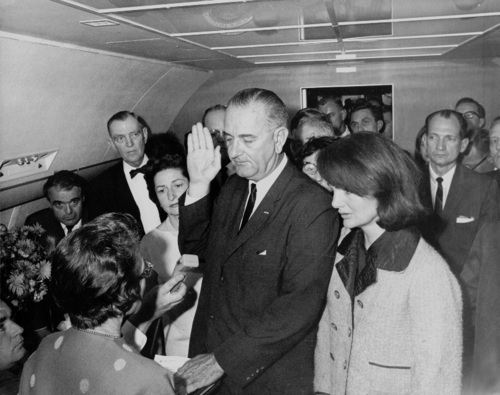
25th Amendment
Section 1.
In case of the removal of the President from office or of his death or resignation, the Vice President shall become President.
Section 2.
Whenever there is a vacancy in the office of the Vice President, the President shall nominate a Vice President who shall take office upon confirmation by a majority vote of both Houses of Congress.
Section 3.
Whenever the President transmits to the President pro tempore of the Senate and the Speaker of the House of Representatives his written declaration that he is unable to discharge the powers and duties of his office, and until he transmits to them a written declaration to the contrary, such powers and duties shall be discharged by the Vice President as Acting President.
Section 4.Whenever the Vice President and a majority of either the principal officers of the executive departments or of such other body as Congress may by law provide, transmits to the President pro tempore of the Senate and the Speaker of the House of Representatives their written declaration that the President is unable to discharge the powers and duties of his office, the Vice President shall immediately assume the powers and duties of the office as Acting President. Thereafter, when the President transmits to the President pro tempore of the Senate and the Speaker of the House of Representatives his written declaration that no inability exists, he shall resume the powers and duties of his office unless the Vice President and a majority of either the principal officers of the executive department or of such other body as Congress may by law provide, transmit within four days to the President pro tempore of the Senate and the Speaker of the House of Representatives their written declaration that the President is unable to discharge the powers and duties of his office. Thereupon Congress shall decide the issue, assembling within forty-eight hours for that purpose if not in session. If the Congress, within twenty-one days after receipt of the latter written declaration, or, if Congress is not in session, within twenty-one days after Congress is required to assemble, determines by two-thirds vote of both Houses that the President is unable to discharge the powers and duties of his office, the Vice President shall continue to discharge the same as Acting President; otherwise, the President shall resume the powers and duties of his office.
What happens when the presidency is vacated before an election? The vice president becomes president and then selects a vice president that must be confirmed by both houses of Congress. What if something should happen to the President and Vice President at the same time? Then the speaker of the house takes the presidency, and the President pro tempore of the Senate becomes vice president. The line of succession then goes to the Cabinet members, in the order of their creation.
Order of Succession to the Presidency
|
1 — President of the United States |
|
2 — Vice-President of the United States |
|
3 — Speaker of the House of Representatives |
|
4 — President of the Senate Pro Tempore (becomes VP when Speaker becomes President) |
|
(Cabinet Secretaries in Order of Post's Creation — see Unit 7) |
|
5 — Secretary of State |
|
6 — Secretary of the Treasury |
|
7 — Secretary of Defense |
|
8 — Attorney General |
|
9, etc. — Remaining Cabinet Secretaries |
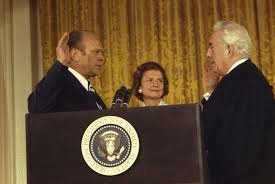
Video: Nixon's Resignation Address
Video: Gerald Ford Takes the Oath of Office
Presidential Disability and the 25th Amendment
The 25th Amendment concerns presidential disability, or what to do with the presidency if the President cannot perform the duties of the president. It is an issue that the Framers only gave the most cursory of thought to, relatively speaking. They were concerned about continuity of power, and provided for a vice president to replace the president, should anything ever happen. As time went on, vice presidents did eventually replace presidents as they died in office. For reference, a list of presidents who died in office follows:
| 9th President William Henry Harrison, died April 4, 1841 |
| 12th President Zachary Taylor, died July 9, 1850 |
| 16th President Abraham Lincoln, died April 15, 1865 |
| 20th President James Garfield, died September 19, 1881 |
| 25th President William McKinley, died September 14, 1901 |
| 29th President Warren G. Harding, died August 2, 1923 |
| 32nd President Franklin Delano Roosevelt, died April 12, 1945 |
| 35th President John F. Kennedy, died November 22, 1963 |
In each of the cases above, a vice president eventually took over the duties of the president as described in the Constitution. But the assassination of President Kennedy in 1963 caused many people great concern over the continuation of government in the case of a president’s disability. President Kennedy had suffered a fatal head wound and many in Congress were concerned that had the President’s wound not been fatal, there was a very real chance that he could have lived for some time, yet have been in a coma, or he could have lived and been in a diminished mental state. President Lincoln had suffered a similar head wound and had lived for several hours before he passed away. What would be done in the case of a president who suffered a disabling yet non-fatal wound or other medical trauma? The Constitution only allowed for the vice president to assume the presidency if the president died, resigned, or was impeached. A president in a coma could hardly resign, and would there be grounds for impeachment?
The question was actually far from a new one. Medical science, though, had advanced to a place where such questions could be asked. Harrison died of pneumonia a month after taking office. One hundred years later, he might have lived. Taylor died of cholera morbus, or acute indigestion, which surely would not have been fatal today. Lincoln, of course, was shot in the head, but it was over eight hours later that he died.
The first real issue with presidential disability arose with President Garfield who, shot by an assassin's bullet and was incapacitated for 11 weeks before passing away from a secondary infection caused by the wounds he received. But Garfield and his vice president, Chester Arthur, had not been on good terms with each other and had had a hostile working with relationship with Garfield’s Cabinet before his death. Even after this crisis in government, the chance to revise the Constitution in order to allow for the continuation of government in the case of presidential disability was not taken up.
President McKinley was shot just after the beginning of his second term and died eight days afterward, the victim of gangrene (again, an infected wound). President Harding's death was relatively quick - after a grueling schedule of speeches, he was ordered to rest by his physicians; later, he collapsed and died four days later. Finally, President Roosevelt died while away for rest in Warm Springs, Georgia. His passing was also relatively quick.
The experiences of previous presidential disabilities and new concerns after the assassination of President Kennedy finally pushed Congress towards reconsidering the line of presidential succession and especially the case of presidential disability. The United States had now become a major world “superpower” and concerns over the continuation of government became a critical question for Congress. The question at hand became “can the United States afford to have any substantial time without a clear picture of who the president is?”
The 25th Amendment was the answer to that question--the United States could not afford to have any doubts about who was at the helm. The 25th ensures that the entire nation and the entire world is clear who the leader is even in a time of uncertainty.
The 25th Amendment
The 25th Amendment basically outlines a plan for the continuation of government and clearly paves a legal way for the vice president to assume power, taking it from the president in cases of disability or when the president is deemed unable to carry out his Constitutional duties. But no radical changes were made to the automatic line of succession except what was clearly instituted before: upon the death, resignation, or impeachment of the president, the vice president becomes the president. But in a case of disability short of death, a clear set of procedures is to be followed in order to allow for the proper continuation of government.
Step 1: Declaration of Disability
In order to remove a president from power, the vice president and a majority of the department secretaries must send a message to the speaker of the house and the president pro tempore of the Senate, which states that the president is unable to fulfill his or her duties as president. It is important to note here that the majority is of "the executive departments" and not of "the Cabinet." While the Cabinet is often used as a shorthand term for the executive departments, it technically consists of other persons, such as the White House chief of staff and some agency head who play a major role in advising the President on important issues. These people are not a part of the 25th Amendment process.
After this message is signed and sent, the vice president immediately becomes acting president.
Step 2: Declaration of Ability
If the president is not physically disabled, he or she may disagree with the actions of his vice president and department secretaries. If the president disagrees and is physically able, he or she can send a message to the speaker of the house and the president pro tempore of the Senate, stating that he/she is of sound mind and physically able to perform as president. In this case, the president is immediately restored to full power as president.
Step 3: Re-declaration of Disability
If the president disputes the previous declaration of disability, a clock starts ticking. If within four days of the president's objection the vice president and the department secretaries again declare the president disabled to the speaker and the president pro tempore, the decision to declare the president disabled or incapacitated falls upon Congress.
If it is not already in session, Congress must convene within 48 hours and another clock begins ticking. Twenty-one days after the vice president's second declaration of disability, Congress must make a decision as to whether or not the president is disabled. If Congress decides, by a required two-thirds majority of each house, that the president is disabled, then the president must relinquish his/her office and the vice president becomes acting president. During the period in which Congress is making its decision, the vice president holds the position of acting president. If the Congress agrees with the statement of disability, then the vice president continues as acting president. If a two-thirds majority in both chambers of Congress cannot be reached within 21 days, the president resumes his/her duties.
Step 4: Resumption of Power
The 25th Amendment never actually allows for the permanent removal of the president in cases of disability--only for the vice president to become acting president. If there comes a time when the president is able to resume his/her duties and the vice president agrees at any time that the president is able, he/she can give up his powers as acting president. It also would appear from the wording of the amendment that if the vice president were to lose the support of more than half the department secretaries, the president would also resume his/her duties.
The Case of Self-removal
The 25th Amendment provides for the president to remove him/herself from the role of president, which places the vice president directly into the role of acting president. In this case, the president informs the speaker and president pro tempore of his/her disability and upon doing so, the vice president becomes acting president. By simple declaration of ability, reversing the prior message, the president can resume power at any time.
This part of the 25th Amendment was actually invoked when President George W. Bush turned over power to vice president Richard Cheney in June 2002 while he went under general anesthesia for a colonoscopy. When President Ronald Reagan was shot just months into his first term in office, he delegated his powers to Vice President George Bush, but in this case, President Reagan expressly denied invocation of the 25th Amendment. The first President Bush did fall ill a few times during his term, but he never invoked the 25th. In 1996, a panel of historians urged that presidents take greater care when there was to be planned disability such as general anesthesia. Presidents Clinton and Bush both had made formal but secret arrangements for transfer of power in such circumstances, and Bush's 2002 declaration was the first time the recommendations were put into effect.
"Who's In Charge?" -- The Case of The Reagan Assassination Attempt
Watch the video below then answer the following question:
According to the 25th Amendment, who was "in charge?" How does this video demonstrate why the 25th Amendment exists?
Other Instances of Succession
In each of the previously mentioned cases, the vice president assumed office upon presidential death. But in one instance, that of President Richard Nixon, the vice president became president because of a resignation. Gerald Ford is, to date, the only vice president to replace a president for a reason other than death and the only president never to be elected to the office of president or vice president.
President Ford himself came to the vice presidency because of the 25th Amendment. He was President’s Nixon's replacement for his first vice president, Spiro Agnew, who resigned from office in the wake of a tax scandal, and Nixon replaced him with Ford under the second section of the 25th Amendment. Prior to the 25th Amendment, there was no provision for the replacement of a vice president. When a vice president replaced a president, then, the office of vice president remained open until the next election. President Ford invoked the second section of the 25th Amendment himself to nominate his vice president, Nelson Rockefeller.
Source: Mount, Steve. "Constitutional Topic: Presidential Disability." USConstitution.net. 30 Nov 2001. http://www.usconstitution.net/consttop_pdis.html. Accessed 26 April, 2015.
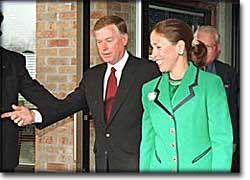
Video: Dan Quail Blooper Reel
What does the vice president do? The only given constitutional duty is to preside over the Senate, a job with virtually no power since the vice president can only vote in the event of a tie. Indeed, the nation's first vice president, John Adams, called the post "the most insignificant office that ever the invention of man contrived."
The president, then, has almost total control over what the vice president does. If he chooses to give him many responsibilities, The vice president can have a significant amount of power if the president is willing to delegate it.
In recent years presidents have given their vice presidents more and more to do. They have headed commissions and organized major projects. The vice president often makes goodwill missions and attends ceremonies and celebrations. If the President regularly asks for advice, then the vice president has some real, though indirect, power.
This dependency on the president has made it very difficult for a vice president to successfully run for president. Only twice in American history has a seated vice president been elected to the presidency. In 1837, Vice President Martin Van Buren succeeded Andrew Jackson, and in 1989, Vice President George Bush succeeded Ronald Reagan. In neither case, did they win reelection.
Study/Discussion Questions
1. What tools does the president have to set the political agenda? What determines what’s on the president’s own agenda?
2. How do presidents use their veto power?
3. What are the disadvantages of vetoing or threatening to veto legislation?
4. How does the president’s position as chief executive allow him to act quickly and decisively?
5. What powers does the president have to respond to events directly?
6. What factors affect the president’s public approval ratings?
7. What can presidents do to increase their approval rating?

